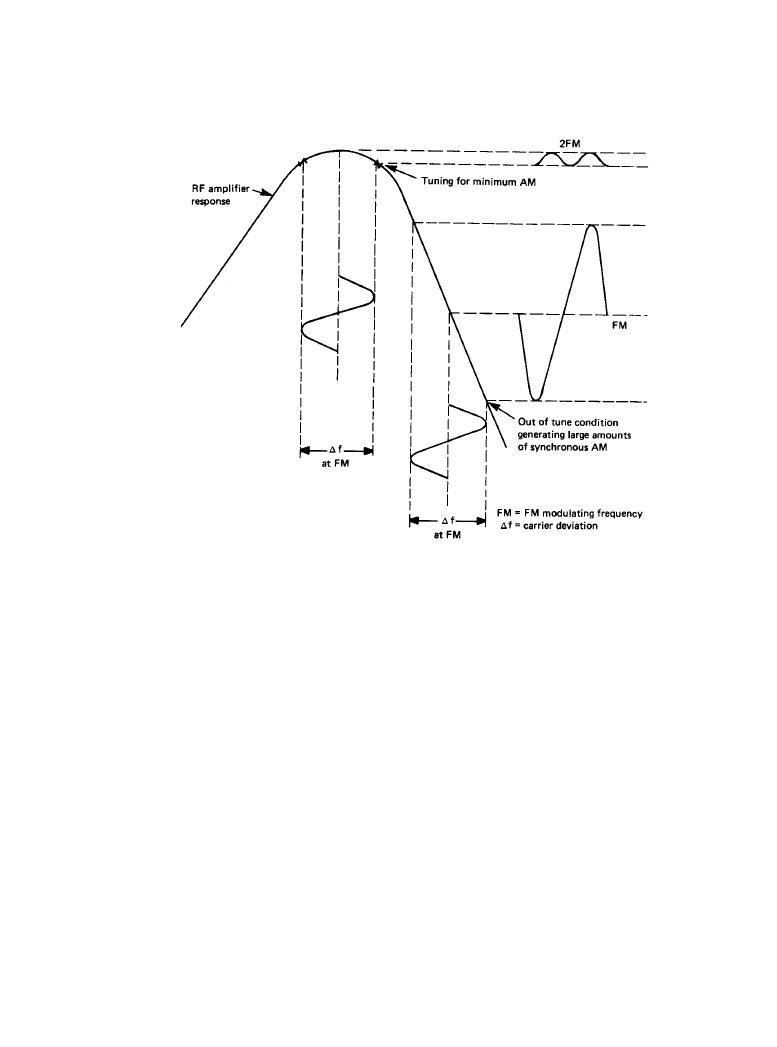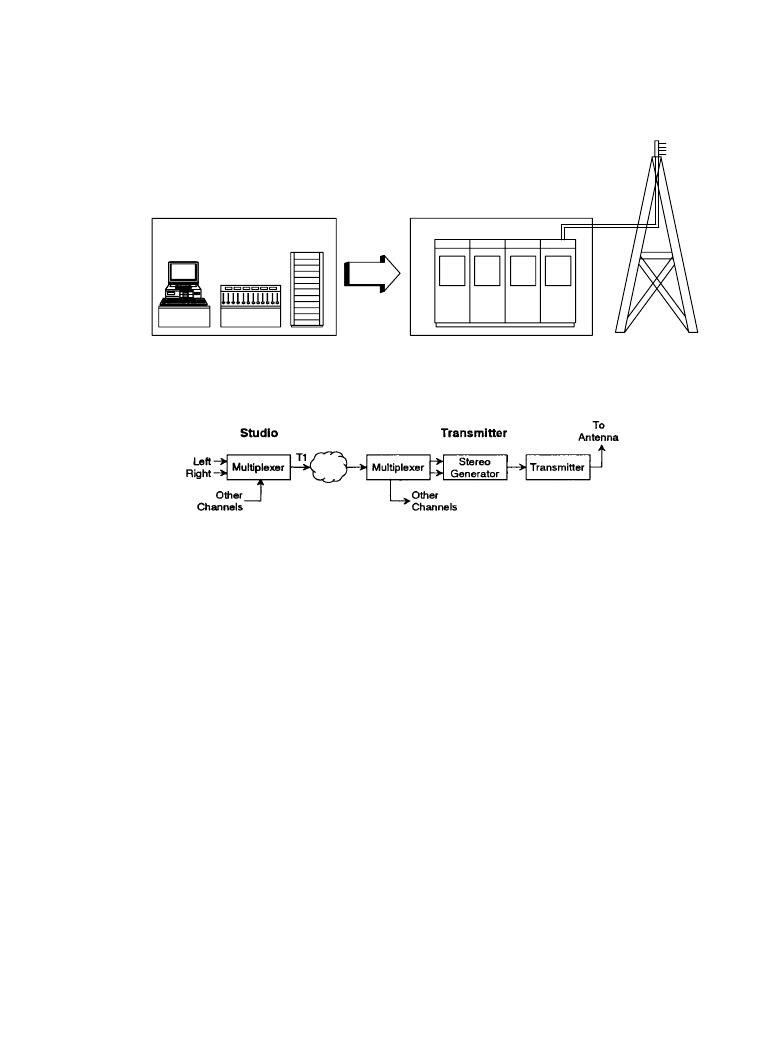ВУЗ: Казахская Национальная Академия Искусств им. Т. Жургенова
Категория: Книга
Дисциплина: Не указана
Добавлен: 03.02.2019
Просмотров: 21672
Скачиваний: 19

11-62 Broadcast Transmission Systems
allocation make it necessary to restrict the bandwidth of all FM broadcast signals. Bandwidth
restriction brings with it the undesirable side-effects of phase shifts through the transmission
chain, the generation of synchronous AM components, and distortion in the demodulated output
of a receiver.
In most medium- and high-power FM transmitters, the primary out-of-band filtering is per-
formed in the output cavity of the final stage. Previous stages in the transmitter (the exciter and
IPA) are designed to be broadband, or at least more broadband than the PA.
As the bandwidth of an FM transmission system is reduced, synchronous amplitude modula-
tion increases for a given carrier deviation (modulation). Synchronous AM is generated as tuned
circuits with finite bandwidth are swept by the frequency of modulation. The amount of synchro-
nous AM generated is dependent on tuning, which determines (to a large extent) the bandwidth
of the system. Figure 11.3.12 illustrates how synchronous AM is generated through modulation
of the FM carrier.
Incidental Phase Modulation
Before the advent of AM stereo, few AM broadcast engineers understood the term incidental
phase modulation (IPM), let alone concerned themselves with its effect on AM transmitters.
Figure 11.3.12
Synchronous AM is generated by one or more narrow-band stages in an FM trans-
mitter. The amount of AM produced is a function of the flatness of the composite RF system.
Downloaded from Digital Engineering Library @ McGraw-Hill (www.digitalengineeringlibrary.com)
Copyright © 2004 The McGraw-Hill Companies. All rights reserved.
Any use is subject to the Terms of Use as given at the website.
Radio Broadcasting

Radio Broadcasting 11-63
IPM is defined as phase modulation produced by an AM transmitter as a result of amplitude
modulation. In other words, as an AM transmitter develops the amplitude-modulated signal, it
also produces a phase modulated, or PM, version of the audio as well.
In theory, IPM is of little consequence for monophonic AM because FM and PM do not affect
the carrier amplitude. An envelope detector will, in theory at least, ignore IPM. This is true to a
point; however, stations attempting to broadcast AM stereo must pay close attention to IPM. Any
undesired carrier phase modulation, such as IPM, will have an effect on stereo performance.
As a general rule, because IPM is a direct result of the modulation process, it can be gener-
ated in any stage that is influenced by modulation. The most common cause of IPM in plate-
modulated and pulse-modulated transmitters is improper neutralization of the final RF amplifier.
Adjusting the transmitter for minimum IPM is an accurate way of achieving proper neutraliza-
tion. The reverse is not always true, however, because some neutralization methods will not nec-
essarily result in the lowest amount of IPM.
Improper tuning of the IPA stage is the second most common cause of IPM. As modulation
changes the driver loading to the PA grid, the driver output also may change. The circuits that
feed the driver stage usually are isolated enough from the PA that they do not produce IPM. An
exception can be found when the power supply for the IPA is influenced by modulation. Such a
problem could be caused by a loss of capacitance in the high-voltage power supply itself.
11.3.5 Bibliography
Bordonaro, Dominic: “Reducing IPM in AM Transmitters,” Broadcast Engineering, Intertec
Publishing, Overland Park, Kan. May 1988.
Crutchfield, E. B. (ed): NAB Engineering Handbook, 8th ed., National Association of Broadcast-
ers, Washington, D.C., 1992.
Downloaded from Digital Engineering Library @ McGraw-Hill (www.digitalengineeringlibrary.com)
Copyright © 2004 The McGraw-Hill Companies. All rights reserved.
Any use is subject to the Terms of Use as given at the website.
Radio Broadcasting

Downloaded from Digital Engineering Library @ McGraw-Hill (www.digitalengineeringlibrary.com)
Copyright © 2004 The McGraw-Hill Companies. All rights reserved.
Any use is subject to the Terms of Use as given at the website.
Radio Broadcasting

11-65
Chapter
11.4
Radio STL Systems
Jerry C. Whitaker, Editor-in-Chief
11.4.1 Introduction
One of the major concerns in the design and operation of a radio broadcasting facility is the
means by which the program audio from the studio is conveyed to the transmitter site. As illus-
trated in Figure 11.4.1, this link represents an important element in the overall reliability of the
transmission chain. Furthermore, as digital technology continues to move into daily radio station
operation, the studio to transmitter link (STL) must become as transparent as possible. An infe-
rior link will impose an unacceptable limit on overall audio quality. The requirements for reli-
ability and transparent program relay have led to the development of new STL systems based on
digital technology.
Changes in FCC broadcast ownership rules and the popularity of local marketing agreements
(LMAs) have reshaped radio broadcasting. The need for high-quality audio programming is one
outgrowth of new competition and new alliances. STL systems are an important component of
these audio improvement efforts. Furthermore, increasing numbers of stations are using intercity
relay (ICR) facilities to share programming. Unfortunately, in many areas of the United States,
the demand for 950 MHz STL channels has far outstripped the available supply. The Part 74
bandwidth allocations for STL systems, therefore, necessitate highly-efficient designs to meet
the needs of radio broadcasters today.
Market demand for STL systems is not limited to North America. The commercialization of
radio broadcasting in Europe and elsewhere has led to increased use of radio links to relay pro-
gramming from one studio to the next, and from the studio to the transmitter site. In some areas,
repeated use of the same frequency places stringent demands on system design.
11.4.1a
Radio vs. Landline Links
The arguments over which approach—radio STL or landline (telco)—is the better way to convey
program audio from the studio to the transmitter is as old as radio broadcasting itself. Now, how-
ever, a new element has been added to the equation that makes the landline option considerably
more attractive. That new element is digital technology.
For years, broadcasters were limited in their choice of STL equipment to two main options:
950 MHz radio, and equalized analog telephone lines. Today, a third approach, T1 digital trans-
Downloaded from Digital Engineering Library @ McGraw-Hill (www.digitalengineeringlibrary.com)
Copyright © 2004 The McGraw-Hill Companies. All rights reserved.
Any use is subject to the Terms of Use as given at the website.
Source: Standard Handbook of Audio and Radio Engineering

11-66 Broadcast Transmission Systems
mission, is rapidly becoming the system of choice for many radio stations [1]. The decision to
use T1 may be based on several factors, including:
•
Necessity. The station has no line-of-sight to the transmitter, or suitable frequencies are
unavailable.
•
Sound quality. A digital STL can sound better than even the best analog systems.
•
Cost. A single leased T1 line can cost less than multiple leased analog lines.
Whatever the reasons, a broadcaster who decides to use T1 transmission must then choose what
type of system to implement. Digital T1 STL systems can be designed either to transmit discrete
left and right channel stereo, as shown in Figure 11.4.2, or to transmit a composite stereo signal,
illustrated in Figure 11.4.3.
One of the advantages to a broadcaster in using a T1 digital STL is the ability to multiplex
several signals together. SCAs, SAP channels, transmitter remote control signals, data, and voice
can all be combined with the broadcast audio signal for transmission on a single T1 circuit. The
duplex nature of T1 permits use of the same system for both STL and transmitter-to-studio
(TSL) functions as well. Table 11.4.1 compares T1 bandwidth for various circuit implementa-
tions.
Studio site
Transmitter site
Figure 11.4.1
The basic function of a studio-to-transmitter link. (
After [2].)
Figure 11.4.2
Discrete channel T1 digital audio STL system. (
After [1].)
Downloaded from Digital Engineering Library @ McGraw-Hill (www.digitalengineeringlibrary.com)
Copyright © 2004 The McGraw-Hill Companies. All rights reserved.
Any use is subject to the Terms of Use as given at the website.
Radio STL Systems